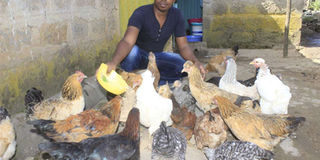Diary of a Poultry Farmer: 29 chicks dead but I am hopeful I can stem spread

Poultry farmer, Mike Ngugi Njoroge feeds his Kienyenji Chicken at Site Estate in Ol Kalou, Nyandarua. Brooding refers to the first two weeks of life when chicks are unable to regulate their body temperature and as a result have to rely on supplemental heat. PHOTO | JOHN GITHINJI | NATION MEDIA GROUP
What you need to know:
- The last thing I wanted to hear was that the infection was still persisting but there was the possibility that the cold season that starts in June could also be a problem.
- For the first seven days, the heat requirement is 32 degrees Celcius, he told me. After the seventh day, the chicks can tolerate lower temperature of between 28 and 30 degrees Celcius because by then, they will have started to form feathers.
- Another thing the vet advised was to spray the wood shavings with a disinfectant and leave to dry before chicks arrive.
- I am still confident that disease outbreaks will be a thing of the past on my farm with the measures I have put in place.
I woke up on Tuesday morning to this news from my farm manager: “Chicks are showing general body weakness, unable to move and sleepy.”
He also informed me that five chicks had died and 20 others were showing signs of illness.
“Not again,” I exclaimed. Deep down, I thought the worst considering my previous experiences.
I instructed him to call the vet immediately. He advised to check temperature of the brooder by observing physical behaviour of the chicken, top up the wood shavings and continue giving chick starter for two weeks and adequate feeds.
You see, exactly two weeks ago, I recounted my fresh start as I brought in new chicks after a six-month hiatus (SoG Jun 17).
The reason for this break was to buy time to clean my infected chicken houses to get rid of two nasty infections (SoG May 20 and May 27). At the peak of the attack in December, I had lost about 594 (a 72 per cent death rate) of the stock.
So, the last thing I wanted to hear was that the infection was still persisting but there was the possibility that the cold season that starts in June could also be a problem.
For sure, I remember one farmer who recounted to me how he had lost hundreds of chicks during the first two weeks of life (SoG June 4, 2016).
In fact, some farmers have confessed to me that they prefer to buy chicks after one month when they don’t have to bother much about supplementing heat during the day and night.
Brooding refers to the first two weeks of life when chicks are unable to regulate their body temperature and as a result have to rely on supplemental heat.
In my case, I was using a jiko and charcoal because my farm is not connected to the main electric grid. Apart from temperature management, the vet advised me to ensure adequate feeds, clean water, and proper ventilation.

Supplemental heat provision chart for kienyeji chicks. CHART | COURTESY
For the first seven days, the heat requirement is 32 degrees Celcius, he told me. After the seventh day, the chicks can tolerate lower temperature of between 28 and 30 degrees Celcius because by then, they will have started to form feathers.
A THING OF THE PAST
In fact, one thing I asked Cleophas over the phone was the behaviour of the chicks especially at night when it gets very cold.
When he told me that he had observed the chicks were crowding together instead of moving about freely I sensed danger and advised him to increase the jikos to four.
From my previous experience, the danger of using jikos is carbon monoxide poisoning but I am not worried about this because the brooding house is well ventilated.
I also provide chick formula to boost immunity and liquid paraffin to aid digestion in the first week. Some farmers confuse liquid paraffin with paraffin (kerosene) used as fuel but the two are different.
Within seven days, he had used five bags of charcoal. With a bag retailing for Sh1700, the cost came to Sh8,500. Within two weeks, I have spent Sh17,000 on heating alone.
Another thing the vet advised was to spray the wood shavings with a disinfectant and leave to dry before chicks arrive. He cautioned against using saw dust (fine wood particles) since chicks can ingest it leading to indigestion.
I am still observing hygiene practices (farm biosecurity measures) that I have put in place and I administered the first Gumboro vaccine yesterday.
One thing I have observed which worries me is some chicks have developed paralysis of limps and as a result of this they get trampled on and die.
The vet told me this could be Marek’s disease and I need to get in touch with Kalro in Naivasha because I am told the vaccine against this disease should have been given at their hatchery.
So far, we have lost 29 chicks out of 500 which amounts to five per cent death rate.
I am still confident that disease outbreaks will be a thing of the past on my farm with the measures I have put in place. You will be hearing from me in the coming months





